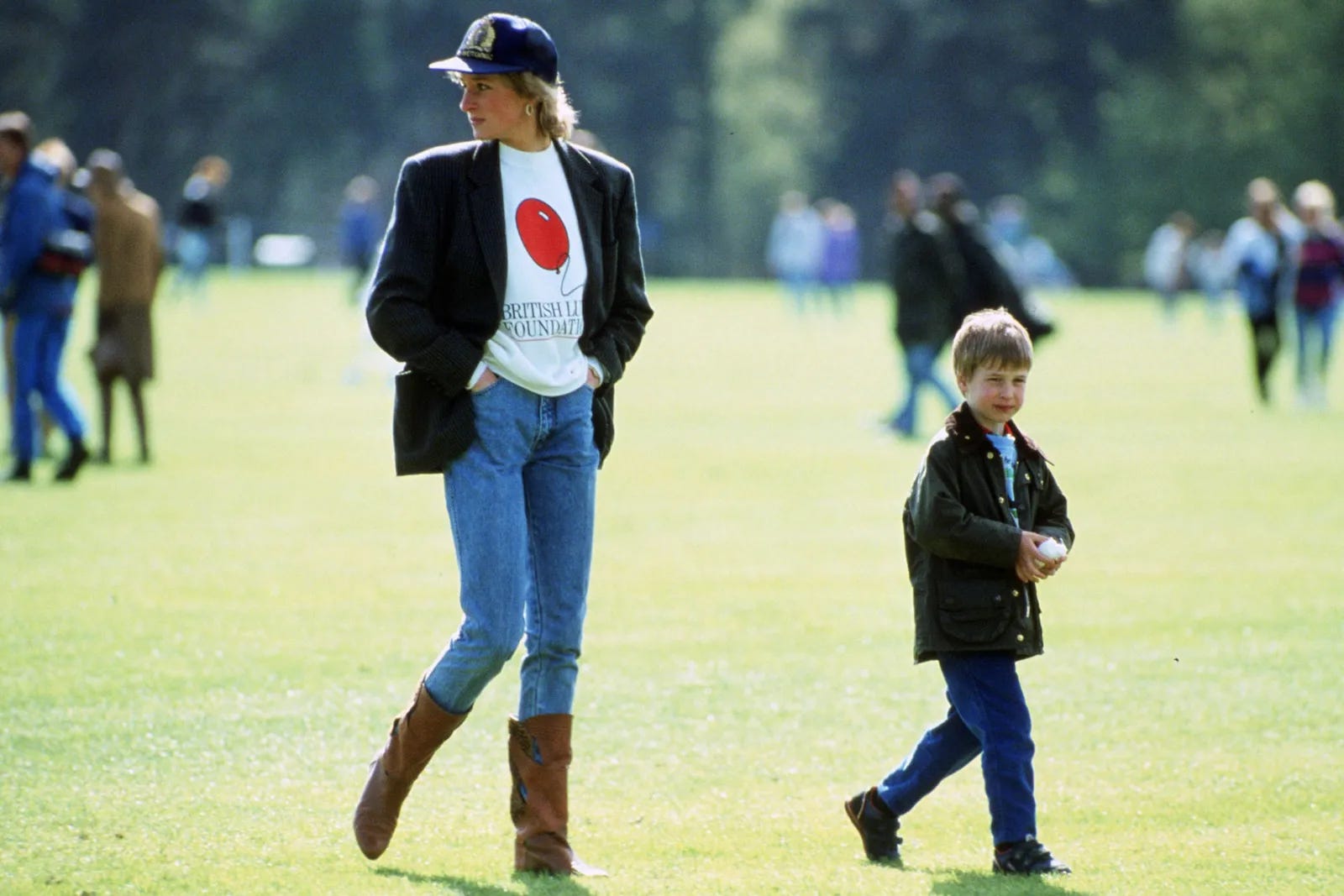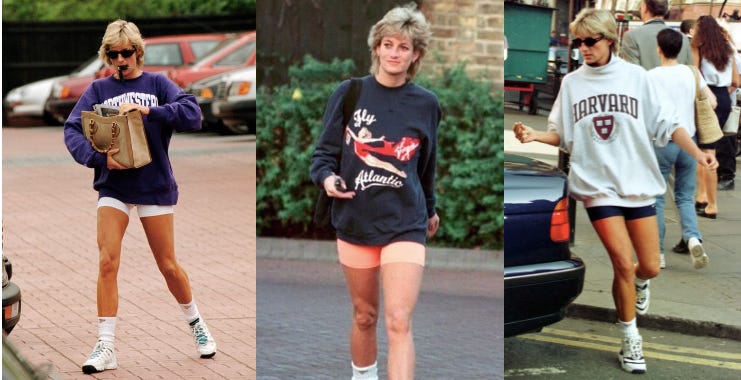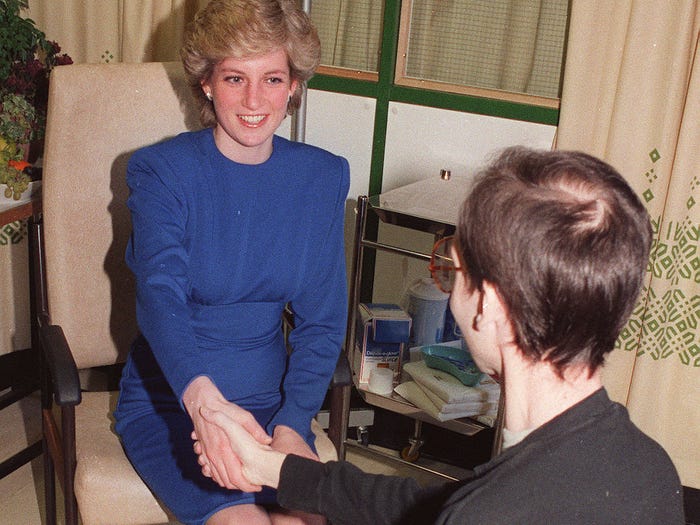Paging Dr. Lesbian - Diana, Princess of Lesbians
Princess Diana, also known as Lady Diana Spencer or Diana, Princess of Wales, has often been considered a gay icon, primarily because of her indelible work during the AIDs crisis. Indeed, Diana has been a hero to many people from all walks of life, her designation as “The People’s Princess” illustrating as much. More recently, over 20 years after her death, she seems to have formed another alliance with an unlikely group: lesbians and queer women. The most recent illustration of this association is in the new film about Princess Diana, Spencer, starring Kristen Stewart. The film, billed by director Pablo Larraín as a “fable from a true tragedy,” follows Lady Di over the course of three anxiety-filled days in December of 1991. Both the plot of the film itself, as well as Kristen Stewart’s role in it and her own outsized celebrity persona, lend the film to a queer reading. First, the plot. [Spoilers ahead]. Spencer follows Diana around Sandringham Estate as she fights the confinement placed upon her by her royal title, her struggles with this control manifesting themselves through an eating disorder and self-harm. The only bright spots in her life seem to be her relationships with her children and a loyal dresser who she also considers a friend. In one of the film’s twists (an unexpected notion in a movie about someone whose life was so closely documented when she was alive), it’s revealed that her dresser, played by Sally Hawkins, is in love with Diana, and not in a platonic way. While Hawkins’ character in the film is entirely made-up, her presence does seem to suggest that Diana attracted queerness in some way, or was attracted to it. This assumption does seem to bear out in Diana’s own life – she did in fact have a gay butler, and according to him, only Diana knew he was gay and she accepted him for it. Diana was also good friends with both Freddy Mercury and Elton John, and, one fateful evening, Freddy and his friends actually snuck Diana into a gay bar in drag. Kristen Stewart playing the role of Diana is also a telling casting choice. Certainly, you could argue that a queer actress playing Princess Diana is meaningful in and of itself, but it’s more than that. As Kyle Buchanan writes in the New York Times, Stewart’s casting was a “meta stroke of genius,” as she “may be one of the few actresses with an inkling of what it’s like to be so often hounded by the paparazzi.” Stewart herself has been reticent to actually draw comparisons between her own life and Diana’s, noting that she hasn’t experienced the same amount of exacting control that Diana was forced to endure. Nonetheless, her casting is clearly quite purposeful, as Stewart – the highest-paid woman actress in the world at 22 – has often shirked expectations and fought against the role of celebrity that was bestowed upon her. Indeed, casting a slouching, converse-clad iconoclast American actress as Diana works precisely because Stewart doesn’t fit in the gilded world into which she is placed – and neither did Diana. Stewart, after all, has been the unlikely face of Chanel since 2013, embodying a refreshing contradiction in this apparent incongruity. As Buchanan writes, “Instead of becoming the classic ideal of a Chanel woman, Stewart wrests that ideal toward her, and the distance that remains between those two extremes is the thing that catches and keeps your eye.” Diana famously used fashion in a similarly powerful manner, to express herself or maintain her freedom when words wouldn’t do. Stewart is not the only queer actor to play Diana either. Emma Corrin, who is also queer, played Diana in The Crown before Elizabeth Debicki took over. (I should note here that while Debicki has not said she herself is queer, she is nonetheless beloved by some lesbians and queer women, partially because she played Virginia Woolf in Vita & Virginia, and partially because she is like, really tall). Corrin discussed their queerness earlier this year, noting that "I think that we're so used to defining ourselves. And that's the way, sadly, society works, is within these binaries, and it's taken me a long time to realize that I exist somewhere in between." Certainly, the number of queer (or queer-adjacent) actors that have played Diana may not be statistically significant when looked at quantitatively (there have been many Dianas over the years), but qualitatively, the recent interest in Princess Diana from queer viewers tells its own story. While it’s certainly true that an actor’s sexual orientation need not overlap with the roles they play, Stewart and Corrin’s visible queerness clearly adds another layer of meaning to their respective roles as the People’s Princess. What exact meaning is taken from these two performances is, of course, up to each viewer to decide. Much of Diana’s celebrity persona was connected to her fashion, which, at least in the eyes of spectators, often became a way for Diana to express herself within (and outside of) the confines of her royal status. In 2018, a magazine editor with a degree in fashion started an Instagram account called princessdianalookinggay, and it quickly gained popularity. (The account has since been deleted). The account featured pictures of Diana where she looked particularly sapphic – her famous bike shorts and sweatshirt combo, the various suits and tuxes she wore, many of her more casual looks, such as jeans and a blazer – and from them on conversations about Diana became more queerly focused, at least on this part of the internet. The creator of the account, Lauren Pellerano Gomez, initially started the project as something of a joke – she searched “Princess Diana looking gay” to see if anyone had used the hashtag before and found no results – and was surprised how quickly it gained traction. Speaking with Vanity Fair, Pellerano Gomez noted that she thinks Diana is “definitely part of the queer lexicon,” and fashion is a central component of this. Though Diana’s many lesbian-esque fashion choices have only recently been discussed publicly, the notion of lesbian fashion being central to a lot of mainstream fashion trends is not new. Krista Burton in The New York Times has argued that lesbians originated many of today’s popular fashion trends, most notably that of the hipster. Kurt Cobain’s iconic grunge style apparently emerged because he started dressing like Courtney Love’s lesbian friends. (His sister Kim is also a lesbian, which might have something to do with it). For this reason, there is certainly a lot of joy to be found in identifying and celebrating so-called lesbian fashion trends, whether or not the bearers of such fashions are lesbians themselves. It’s long been understood that Princess Diana is a hero to many gay men as a result of her actions during the AIDS crisis in the 1980s and 1990s. She was instrumental in changing attitudes about HIV and AIDS during this time, especially in regards to ideas about those who suffered from the disease themselves. Most famously, in 1987 Diana shook hand with an HIV-positive patient at a time when many in the general public thought you could get AIDS simply from skin contact. Of her thoughts on the matter, she said in 1991: “HIV does not make people dangerous to know, so you can shake their hands and give them a hug. Heaven knows, they need it.” She was still an official patron of the National AIDS Trust at the time of her death in 1997. Certainly, such actions endeared her not only to gay men but to lesbians as well – some of them known as “Blood Sisters” – who often acted as caregivers to gay men with AIDS and have since been recognized as unsung heroes of the crisis. More generally, Diana has been recognized as a queer icon for the ideas she represented and the way her life played out a familiar narrative. As David Levesley writes in Them, “what has always compelled me about Diana is the sense that her doom was not a shock, but an inevitability.” Indeed, when viewed as a story of confinement and repression, of not fitting in, Diana’s story certainly takes on a queer hue. As Levesley puts it, “Like all great icons, some have come to admire Diana for her beauty and her dignity. Others — especially queer people — admire her for how long she lasted in the face of a shitty situation.” Diana seems to have known her unconventional way of doing things wouldn’t help her position in the long run. In a famous BBC1 interview she explained that she didn’t see herself ever becoming queen “because I do things differently, because I don't go by a rule book, because I lead from the heart.” Whatever ire she may have received from the royal family, however, did not seem to stop her. “Someone’s got to go out there and love people,” she said. While Diana was quite literally a member of the ruling class (not only was she a royal, but also descended from aristocrats herself), she also somehow transcended this label because of how obviously she didn’t fit within these constraints, and how clearly she longed to be free. This meant that she was particularly beloved by those without access to the type of wealth and status she herself possessed – the working class, people of color, queer people – who easily recognized her liminal position. Diana’s resilience endeared her to another seemingly unlikely group: immigrant mothers, especially Black British mothers. As Alegría Adedeji relays in Harper’s Bazaar, “the gilded cage of the palace and the constant scrutiny are not too dissimilar from the boxes Black British women, mothers especially, are placed in.” Adedeji recalls how Diana’s “small victories” were celebrated by her mother and others like her, those who weren’t able to speak their problems into existence or enact the type of revenge Diana famously did. As Tariro Mzezewa writes in The New York Times, even those women who hailed from countries colonized by the British and experienced such oppression first hand adored Diana despite this, noting her individuality and strength as a reason for this devotion. Clearly, the power of Diana’s story – whether real or constructed – reached and continues to reach across social strata despite many apparent contradictions. Because of this, it’s not surprising that she has received this renewed attention from the lesbian community for reasons both superficial and profound. The nature of celebrity is such that it expands far beyond the individual in question, spawning threads that travel in many different directions and even going so far as to inspire different communities and subcultures along the way. For sapphics, these threads have also traveled some distance, from Instagram fashion blogs to Kristen Stewart swallowing pearls, though the precise meaning of such moments remains somewhat beguiling. Like, one could say, the Princess herself. If you liked this post from Paging Dr. Lesbian, why not share it? |
Older messages
Should Straight Actors Play Gay Characters?
Sunday, November 7, 2021
On The Eternal Question
Representation Won’t Save Us, But It Can Hurt Pretty Bad
Thursday, November 4, 2021
On Netflix, Hope, and False Promises
dispatch from gay christmas
Thursday, November 4, 2021
and something about judith butler dunking on the terfs (again)
You Might Also Like
*This* Is How To Wear Skinny Jeans Like A Fashion Girl In 2025
Wednesday, March 12, 2025
The revival is here. The Zoe Report Daily The Zoe Report 3.11.2025 This Is How To Wear Skinny Jeans Like A Fashion Girl In 2025 (Style) This Is How To Wear Skinny Jeans Like A Fashion Girl In 2025 The
The Best Thing: March 11, 2025
Tuesday, March 11, 2025
The Best Thing is our weekly discussion thread where we share the one thing that we read, listened to, watched, did, or otherwise enjoyed recent… ͏ ͏ ͏ ͏ ͏ ͏ ͏ ͏ ͏ ͏ ͏ ͏ ͏ ͏ ͏ ͏ ͏ ͏ ͏ ͏ ͏ ͏ ͏ ͏ ͏ ͏ ͏ ͏
The Most Groundbreaking Beauty Products Of 2025 Are...
Tuesday, March 11, 2025
Brands are prioritizing innovation more than ever. The Zoe Report Beauty The Zoe Report 3.11.2025 (Beauty) The 2025 TZR Beauty Groundbreakers Awards (Your New Holy Grail Or Two) The 2025 TZR Beauty
Change Up #Legday With One of These Squat Variations
Tuesday, March 11, 2025
View in Browser Men's Health SHOP MVP EXCLUSIVES SUBSCRIBE Change Up #Legday With One of These Squat Variations Change Up #Legday With One of These Squat Variations The lower body staple is one of
Kylie Jenner Wore The Spiciest Plunging Crop Top While Kissing Timothée Chalamet
Tuesday, March 11, 2025
Plus, Amanda Seyfried opens up about her busy year, your daily horoscope, and more. Mar. 11, 2025 Bustle Daily Amanda Seyfried at the Tory Burch Fall RTW 2025 fashion show as part of New York Fashion
Paris Fashion Week Is Getting Interesting Again
Tuesday, March 11, 2025
Today in style, self, culture, and power. The Cut March 11, 2025 PARIS FASHION WEEK Fashion Is Getting Interesting Again Designs at Paris Fashion Week once again reflect the times with new aesthetics,
Your dinner table deserves to be lazier
Tuesday, March 11, 2025
NY delis are serving 'Bird Flu Bailout' sandwiches.
Sophie Thatcher Lets In The Light
Tuesday, March 11, 2025
Plus: Chet Hanks reaches new heights on Netflix's 'Running Point.' • Mar. 11, 2025 Up Next Your complete guide to industry-shaping entertainment news, exclusive interviews with A-list
Mastering Circumstance
Tuesday, March 11, 2025
“If a man does not master his circumstances then he is bound to be mastered by them.” ͏ ͏ ͏ ͏ ͏ ͏ ͏ ͏ ͏ ͏ ͏ ͏ ͏ ͏ ͏ ͏ ͏ ͏ ͏ ͏ ͏ ͏ ͏ ͏ ͏ ͏ ͏ ͏ ͏ ͏ ͏ ͏ ͏ ͏ ͏ ͏ ͏ ͏ ͏ ͏ ͏ ͏ ͏ ͏ ͏ ͏ ͏ ͏ ͏ ͏ ͏ ͏ ͏ ͏ ͏ ͏ ͏ ͏
Don't Fall for This Parking Fee Scam Text 🚨
Tuesday, March 11, 2025
How I Use the 'One in, One Out' Method for My Finances. You're not facing any fines. Not displaying correctly? View this newsletter online. TODAY'S FEATURED STORY Don't Fall for the





